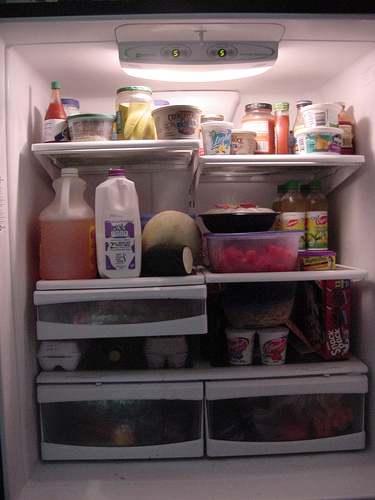Part 2 of Chapter 2 of Runaway Eating: What is Runaway Eating?
The restricting runaway eater is like a person with anorexia nervosa, but milder. Still, such a person tends to worry about getting fat. She might override her hunger signals and cut back her food intake to dangerously low levels.
 While some restricting eaters stop feeling hungry, most have the strong desire to eat and think about food all the time. The other interesting thing to them is being thin and in control. They may check the mirror and buy clothes that are too small, hoping to someday fit into them.
While some restricting eaters stop feeling hungry, most have the strong desire to eat and think about food all the time. The other interesting thing to them is being thin and in control. They may check the mirror and buy clothes that are too small, hoping to someday fit into them.
The difference between a restricting runaway eater and a woman with anorexia is weight. An anorexic has dangerously low weight. The restricting runaway eater may have weight a little lower than average, or normal weight. It’s only a matter of time before her weight drops altogether. Also, she may not restrict as much or as consistently, going through periods where her food intake is normal. However, the food obsession and fear of gaining weight is a constant and close companion.
It’s important to recognize the difference between the restricting runaway eater and the person who is just thin. The naturally thin, like me, don’t always think about food except at mealtimes. She eats until her body tells her to stop, then goes about her business. The restricting runaway eater is obsessed with her weight. How she feels about herself is dependent on whether she can control her food intake. It’s all about her ability to stay thin, become thin, and lose weight. It means self control and achievement to her. She also has a distorted sense of her body size.
 What can restricting do to someone’s body? Vital functions will slow down to conserve energy. Metabolism slows down. Blood pressure drops. You might feel light-headed, dizzy, or cold. Or all three. If body fat drops low enough, your period might stop. You won’t be able to have a baby, because your body realizes that your food supply is too low to support another life. If you are already pregnant, there’s an increased risk of miscarriage, premature birth, and birth defects. You can also get osteoporosis.
What can restricting do to someone’s body? Vital functions will slow down to conserve energy. Metabolism slows down. Blood pressure drops. You might feel light-headed, dizzy, or cold. Or all three. If body fat drops low enough, your period might stop. You won’t be able to have a baby, because your body realizes that your food supply is too low to support another life. If you are already pregnant, there’s an increased risk of miscarriage, premature birth, and birth defects. You can also get osteoporosis.
As if those weren’t bad enough already, there are some extreme effects as well, as if this wasn’t bad enough. Effects such as anemia, kidney failure, heart failure, and death to name a few.
What can it do to your mind and emotions? You may become depressed, withdrawn, or irritable. At night, you might also suffer from insomnia, and when you do sleep, you might dream about food. Your eating habits, obviously, will change. You might eat by chewing each bite a certain number of times, or cutting your food into small pieces. You might even hide your food.
 On the other hand, you may also suffer from anxiety, OCD tendencies, perfectionism, and hopelessness. Each feeds the other. Your feelings feed the disordered eating, while the eating feeds the feelings. It’s a deeply destructive cycle.
On the other hand, you may also suffer from anxiety, OCD tendencies, perfectionism, and hopelessness. Each feeds the other. Your feelings feed the disordered eating, while the eating feeds the feelings. It’s a deeply destructive cycle.
Restrictive eating also takes a toll on relationships. One with this disorder would avoid events with food — basically all of them. I had a friend who didn’t want to go to another friend’s wedding because food was going to be there and she didn’t want to “screw up.” She may also lie about her eating habits. Prospective partners can be turned off, being tired of being asked, “Do I look fat?”
Next up: The Bingeing Runaway Eater



 How many have runaway eating? It’s hard to know for sure. Some people don’t consider themselves to have disordered eating, because they don’t “starve” or “throw up.” It’s estimated that up to 25% of females may live with this condition.
How many have runaway eating? It’s hard to know for sure. Some people don’t consider themselves to have disordered eating, because they don’t “starve” or “throw up.” It’s estimated that up to 25% of females may live with this condition.
 Part 1 of chapter 1 of Runaway Eating: Not for Teenagers Only
Part 1 of chapter 1 of Runaway Eating: Not for Teenagers Only The book Runaway Eating by Cynthia M. Bulik, Ph.D., and Nadine Taylor, M.S., R. D. takes a good look at this trend. They also include an 8 point plan to help conquer this kind of thinking. (I will not go through the 8 point plan because there’s a lot of books to read.) This book, is, however, designed to help the reader make informed decisions about health, and is not a medical manual by any means. And if you are suffering from an eating disorder, it’s best to seek a doctors help rather than to turn to a book alone.
The book Runaway Eating by Cynthia M. Bulik, Ph.D., and Nadine Taylor, M.S., R. D. takes a good look at this trend. They also include an 8 point plan to help conquer this kind of thinking. (I will not go through the 8 point plan because there’s a lot of books to read.) This book, is, however, designed to help the reader make informed decisions about health, and is not a medical manual by any means. And if you are suffering from an eating disorder, it’s best to seek a doctors help rather than to turn to a book alone. Runaway eating runs rampant through society. However, using food as a solution for your problems is no solution at all, as women find out.
Runaway eating runs rampant through society. However, using food as a solution for your problems is no solution at all, as women find out.
 We like to look at pretty faces. Friends are chosen based simply on whether a potential friend is attractive or not. We want to do business with pretty faces. And we want to marry an attractive person. Gordon L. Patzer pointed this out in his book Looks, and all this stuff is supported by research, sad to say. Teachers like pretty students because they feel that the more attractive students show the most potential. Pretty babies get more love and attention first from nurses at the hospital at birth, and then at home with their mothers. Pretty people seem to have an easier time in life. Employees hire pretty people to make their firms successful. Freelancer Jenna Glatzer writes in her book
We like to look at pretty faces. Friends are chosen based simply on whether a potential friend is attractive or not. We want to do business with pretty faces. And we want to marry an attractive person. Gordon L. Patzer pointed this out in his book Looks, and all this stuff is supported by research, sad to say. Teachers like pretty students because they feel that the more attractive students show the most potential. Pretty babies get more love and attention first from nurses at the hospital at birth, and then at home with their mothers. Pretty people seem to have an easier time in life. Employees hire pretty people to make their firms successful. Freelancer Jenna Glatzer writes in her book 
 Moving along…
Moving along… Martin goes on to say that a “starving daughter” is at the center of every “perfect girl.” The face we show to the world is an outward mask that says to our friends that everything is going well. Inside, we’re starving for a lot of things. We’re empty and in need, and they don’t know.
Martin goes on to say that a “starving daughter” is at the center of every “perfect girl.” The face we show to the world is an outward mask that says to our friends that everything is going well. Inside, we’re starving for a lot of things. We’re empty and in need, and they don’t know. And our bodies take the ensuing abuse.
And our bodies take the ensuing abuse. Some doctors encourage the attitude. They’re so tired of the obesity epidemic that they’d do anything to get their patients from that extreme. They forget that there is another extreme at the other end. These doctors want rigorous exercise with restraint in diet, no matter who the patient is. Martin interviewed a girl with an eating disorder. This girl saw a doctor in college. She hoped that he’d notice her weight going down and maybe help her. However, he told her to “keep up the good work!”
Some doctors encourage the attitude. They’re so tired of the obesity epidemic that they’d do anything to get their patients from that extreme. They forget that there is another extreme at the other end. These doctors want rigorous exercise with restraint in diet, no matter who the patient is. Martin interviewed a girl with an eating disorder. This girl saw a doctor in college. She hoped that he’d notice her weight going down and maybe help her. However, he told her to “keep up the good work!”
Misuse
The bingeing runaway eater binges to make herself feel better. Her binges can involve a huge amount of food, or a smaller amount. However, it’s usually high in sugar and easy to eat in large quantities (i.e., ice cream, cake, cookies, peanut butter, jam, honey, or candy).
The binge starts as feeling good, but ends up with the woman feeling disgusted. As the food is eaten rapidly, there is no satisfaction. Sometimes, she’s barely aware of what she’s done. The bingeing runaway eater doesn’t purge, but eats and leaves it at that.
Bingeing is more common than anorexia or bulimia. At the time the book was written, it was not recognized as an official eating disorder. As of now, it has joined the ranks as one of the most common eating disorders among women.
The difference between runaway eating and the eating disorder is the frequency of the binges. Those with the disorder binge an average of two days a week for at least six months. Those with the runaway form binge occasionally, and for shorter periods. There’s no firm dividing line, because both forms are all unhealthy.
What can this disorder do to the body? Bloat. Nausea. The inability to breathe because of a distended stomach. The most common consequence of this type of disordered eating is weight gain. Not all with this disorder are overweight. Not all overweight people have this. However, a binge eating disorder can make the problem worse.
The bingeing/compensating runaway eater binges and THEN compensates for the binge by fasting, vomiting, laxatives, or exercise. This keeps their weight at average to slightly above average.
She’s also afraid of getting fat. She defines her self by her appearance. Not only that, she may find it hard to stick to a diet, and end up bingeing to relieve the stress. After she does so, she panics and think about the food turning into fat.
Here are some things the writers say she might to do compensate:
This category also includes those who purge/compensate without even bingeing.
But what’s the difference between this condition and bulimia. Both include a dissatisfaction with how things are with a desire to regain control. Both binge, then purge. The difference is n the frequency and duration. The clinically defined bulimic demonstrates such behavior at an average of at least two times a week for at least three months. The runaway eater does so less often.
How does purging affect weight? It’s ineffective, at most. Restrictive dieting causes metabolism to slow down, making it harder to burn calories. Vomiting doesn’t empty the stomach completely. A lot of what was already eaten is digested. Laxatives work in the rectum or large intestine after calories have already been absorbed. As a result, those with the disorder are not excessively thin; they’re average or slightly above average.
The authors write that at least 75% of people in each category of eating disorder use exercise to try to avoid gaining weight.
There’s underlying issues of control, power, or self-esteem, continues the authors.
I know a woman who tries to exercise to keep the weight off. If she misses a day, she gets unhappy with herself. Her husband once broke a chair at our Christmas Eve party. The chair was already very weak form years and years of heavy butts sitting on it, and he was an average, rather muscular guy. When he sat on it, it cracked. He felt really bad. I heard from his wife that on Christmas day, he called the gym to see if they were open. He wanted to exercise the fat off or something of the sort. Of course they were not. Gyms typically aren’t open on Christmas. Poor guy.
What can bingeing/compensating do to your mind and emotions? There’s the feelings of panic. You know that you’re harming yourself, thence the feeling of shame. Depression, guilt, headaches, or exhaustion are direct results. Remember that this is a vicious cycle, meaning that the disorder feeds the emotions while the emotions feed the disorder.
Often, bingeing and purging are done in secret. This damages relationships with friends and family. It keeps you from focusing on the important things in life. People who don’t understand only serve to widen the gap between you and them.
Next up: A warning and a hope
2 Comments
Posted in Runaway Eating
Tagged abuse, battle, binge, bulimia, comfort, comment, compensate, complex, control, depressed, destructive, ED, exercise, extreme, food, ice cream, misuse, program, purge, pursuit, restrict, run, trouble